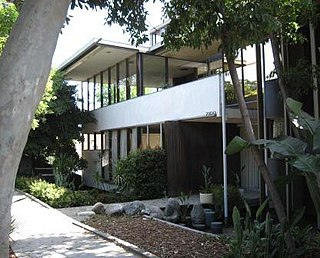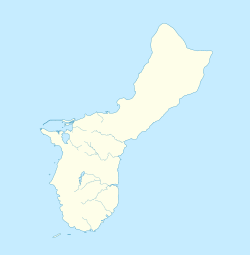
Richard Joseph Neutra was an Austrian-American architect. Living and building for most of his career in Southern California, he came to be considered a prominent and important modernist architect. His most notable works include the Kaufmann Desert House, in Palm Springs, California.

Humåtak is a village on the southwestern coast of the United States territory of Guam. The month of March in the Chamorro language is "Umatalaf," or "to catch guatafi," which is believed to be the root word of Umatac. The village's population has decreased since the island's 2010 census, and it is by far the least populated village on the island.

The Neutra Office Building is a 4,800-square-foot (450 m2) office building in the Silver Lake section of Los Angeles, California. The building was owned and designed by Modernist architect Richard Neutra in 1950. It served as the studio and office for Neutra's architecture practice from 1950 until Neutra's death in 1970. The building has been declared a Historic Cultural Monument and listed on the National Register of Historic Places. It was listed for sale in 2007 at an asking price of $3,500,000.

Rockport High School is a public high school in Rockport, Massachusetts.

Neutra VDL Studio and Residences, the home of architect Richard Neutra, is located in Los Angeles, California. It is also known as the Neutra Research House, the Van der Leeuw House, the Richard and Dion Neutra VDL Research House II, or the Richard and Dion Neutra VDL Research Houses and Studio. It was designed by Richard Neutra and his son Dion Neutra. The house is currently owned by California State Polytechnic University, Pomona, and is maintained by its College of Environmental Design. The property was added to the National Register of Historic Places in 2009, and was designated as a National Historic Landmark in 2016.

The San Dionisio Church Ruins are a historic ruins on Route 2 in Umatac, Guam. They are the remains of a church that was built in 1862 and destroyed by an earthquake in 1892. It was built out of manposteria, and the surviving elements including buttresses rising to a height of 13 feet (4.0 m). The ruins are the only surviving remnant of the Spanish colonial headquarters complex that stood in this area. The first San Dionisio Church was constructed in 1681, but rebuilt after a fire three years later. That church was destroyed in 1849 by an earthquake, and portions may have been used in construction of the 1862 building. A new church was built in 1939. The ruins were added to the National Register of Historic Places in 1974.

Fort Nuestra Señora de la Soledad is a fortification near Umatac, Guam. Built by the Spanish probably between 1802 and 1819, it was the fourth of four fortifications that protected an anchorage for galleons transiting between Acapulco, Mexico and the Philippines, a route that fell out of use in 1815 with Mexican independence.

The Umatac Outdoor Library, located on Guam Highway 4 in Umatac, Guam, was built in 1933 by Francisco Quinata Sanchez and Umatac villagers. It was listed on the National Register of Historic Places in 1999.

The Guam Institute, located off in Guam Highway 1 in Hagåtña, Guam, was listed on the U.S. National Register of Historic Places in 1977; the listing included one contributing building. It was built in 1911. It has also been known as the Jose P. Lujan House.

The McKinley Park School, at Riverside Drive and Keystone Avenue in Reno, Nevada, USA, is a historic school building that was built in 1909. It includes Mission/Spanish Revival architecture and was designed by George Ferris. Also known as the City of Reno, Recreation Center, it was listed on the National Register of Historic Places in 1985.

Cetti Bay is an oceanic bay and historic site near Umatac, Guam, that is listed on the National Register of Historic Places.

The Hanalei Elementary School, on Kuhio Highway in Hanalei, Hawaii, is a public elementary school of the Hawaii Department of Education. It formerly occupied a historic school building that was built in 1926. This building was listed on the Hawaiʻi Register of Historic Places in 1988 and on the National Register of Historic Places in 1990.

Kilauea Elementary School, also known as Kilauea School, on Kolo Rd. in Kilauea, Hawaii, on Kauai, is a public elementary school operated by the Hawaii Department of Education. It occupies a historic school building that was founded in 1882 and known as an "English School". The current school complex, whose main building was built in 1922, was listed on the National Register of Historic Places in 1983; the listing included three contributing buildings on 6.5 acres (2.6 ha).
The Taelayag Spanish Bridge is a historic stone bridge in the United States territory of Guam. It is a stone arch bridge, built sometime between 1866 and 1898, and originally carried the coast road between Agat, Guam and Umatac across Taelayag Stream. It is now located about 1,800 feet (550 m) southwest of Guam Highway 2, the modern coast road. The bridge is a single-span stone arch with a span of 8 feet 10 inches (2.69 m) and a total structure length of 27 feet 9 inches (8.46 m). This bridge, like most of the bridges that survive from the Spanish period in Guam, was probably taken out of service around 1917.
Fort San Jose is a former Spanish fortification on the island of Guam, now a United States territory. It is located north of the village of Umatac, on a hill overlooking both Fouha Bay and Umatac Bay, the place were Spanish galleons traveling between Manila in the Spanish Philippines and Acapulco, Mexico stopped for water and supplies.
Fort Santo Angel was a Spanish fortress on the island of Guam, now a United States territory. Located on a promontory on the west coast of the island in the northernmost part the Umatac Bay in Umatac, the fort's remains are among the oldest known Spanish-era structures on the island; a fort is documented to have been standing here since 1742, and to still be in use in the early 19th century. The fort provided protection for the anchorage used by Spanish galleons on the trade route between Manila and Acapulco, Mexico. Perched on a monolith, there remains a plaza 40 by 24 feet of flagstone surrounded by a manposteria wall 1 foot (30 cm) high and 18 inches (46 cm) thick. The remains of a guardroom and a second, smaller platform, lie to its west.
The Fouha Bay Site is a prehistoric archaeological site near the village of Umatac on the southwestern coast of Guam. First identified in 1977 during a systematic survey by archaeologist Fred Reinman, the site was radiocarbon dated to CE 1200–1400. However, differences in the rate of deposition along stream and river banks make these dates uncertain. Because of a proportionally larger number of archaeological sites in the geologically different parts of eastern Guam, this site is significant in understanding how deposition rates affect site dating methods.

Ulysses Simpson Grant Elementary School is a historic building located in Oskaloosa, Iowa, United States. Built in 1914, it replaced a school of the same name that had been built in 1876. The Neoclassical building was designed by Des Moines architect John W. Trafzer, and built by Buckler and Robertson. It was the first new school built in Oskaloosa in the 20th century, and part of an effort to rebuild or recondition the schools in the city. The addition of a multipurpose facility in 1957 followed the Mother's Crusade of 1956 to rebuild and modernize Oskaloosa schools system after World War II. It was designed by George Russell. Two other additions were built in 1978 and 1980. The building served the school system until 2004, after which the original portion of the building was converted into senior apartments and the newer additions into a senior center. The grounds have become a community park. The building was listed on the National Register of Historic Places in 2008.

Coggon Public School, also known as the Coggon Center, is a historic building located in Coggon, Iowa, United States.

Arthur and Mona Hofmann House, also known as the Hofmann House, was built in 1937 and is a historic home located at 1048 Cuesta Road in Hillsborough, California. The building was designed by Modernist architect Richard Neutra in International Style. It has been listed on the National Register of Historic Places since August 5, 1991. The house is a private residence and not open to the public.

















